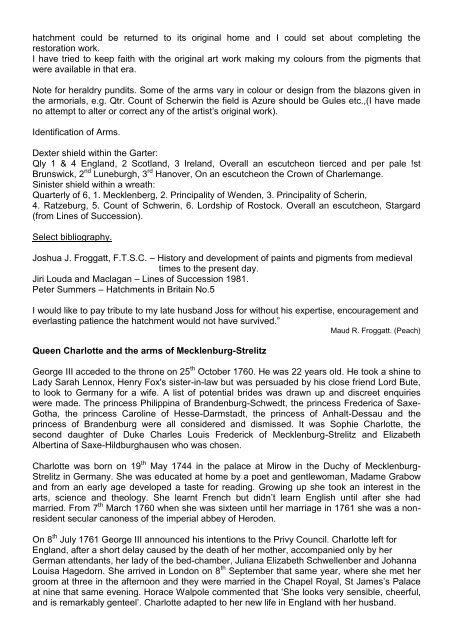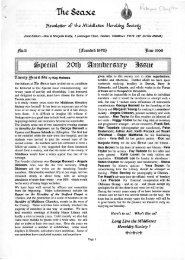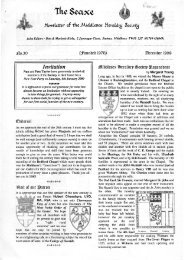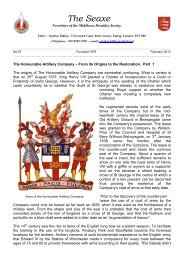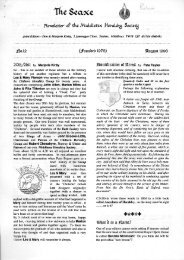The Seaxe - Middlesex Heraldry Society
The Seaxe - Middlesex Heraldry Society
The Seaxe - Middlesex Heraldry Society
You also want an ePaper? Increase the reach of your titles
YUMPU automatically turns print PDFs into web optimized ePapers that Google loves.
hatchment could be returned to its original home and I could set about completing the<br />
restoration work.<br />
I have tried to keep faith with the original art work making my colours from the pigments that<br />
were available in that era.<br />
Note for heraldry pundits. Some of the arms vary in colour or design from the blazons given in<br />
the armorials, e.g. Qtr. Count of Scherwin the field is Azure should be Gules etc.,(I have made<br />
no attempt to alter or correct any of the artist‟s original work).<br />
Identification of Arms.<br />
Dexter shield within the Garter:<br />
Qly 1 & 4 England, 2 Scotland, 3 Ireland, Overall an escutcheon tierced and per pale !st<br />
Brunswick, 2 nd Luneburgh, 3 rd Hanover, On an escutcheon the Crown of Charlemange.<br />
Sinister shield within a wreath:<br />
Quarterly of 6, 1. Mecklenberg, 2. Principality of Wenden, 3. Principality of Scherin,<br />
4. Ratzeburg, 5. Count of Schwerin, 6. Lordship of Rostock. Overall an escutcheon, Stargard<br />
(from Lines of Succession).<br />
Select bibliography.<br />
Joshua J. Froggatt, F.T.S.C. – History and development of paints and pigments from medieval<br />
times to the present day.<br />
Jiri Louda and Maclagan – Lines of Succession 1981.<br />
Peter Summers – Hatchments in Britain No.5<br />
I would like to pay tribute to my late husband Joss for without his expertise, encouragement and<br />
everlasting patience the hatchment would not have survived.”<br />
Maud R. Froggatt. (Peach)<br />
Queen Charlotte and the arms of Mecklenburg-Strelitz<br />
George III acceded to the throne on 25 th October 1760. He was 22 years old. He took a shine to<br />
Lady Sarah Lennox, Henry Fox's sister-in-law but was persuaded by his close friend Lord Bute,<br />
to look to Germany for a wife. A list of potential brides was drawn up and discreet enquiries<br />
were made. <strong>The</strong> princess Philippina of Brandenburg-Schwedt, the princess Frederica of Saxe-<br />
Gotha, the princess Caroline of Hesse-Darmstadt, the princess of Anhalt-Dessau and the<br />
princess of Brandenburg were all considered and dismissed. It was Sophie Charlotte, the<br />
second daughter of Duke Charles Louis Frederick of Mecklenburg-Strelitz and Elizabeth<br />
Albertina of Saxe-Hildburghausen who was chosen.<br />
Charlotte was born on 19 th May 1744 in the palace at Mirow in the Duchy of Mecklenburg-<br />
Strelitz in Germany. She was educated at home by a poet and gentlewoman, Madame Grabow<br />
and from an early age developed a taste for reading. Growing up she took an interest in the<br />
arts, science and theology. She learnt French but didn‟t learn English until after she had<br />
married. From 7 th March 1760 when she was sixteen until her marriage in 1761 she was a nonresident<br />
secular canoness of the imperial abbey of Heroden.<br />
On 8 th July 1761 George III announced his intentions to the Privy Council. Charlotte left for<br />
England, after a short delay caused by the death of her mother, accompanied only by her<br />
German attendants, her lady of the bed-chamber, Juliana Elizabeth Schwellenber and Johanna<br />
Louisa Hagedorn. She arrived in London on 8 th September that same year, where she met her<br />
groom at three in the afternoon and they were married in the Chapel Royal, St James‟s Palace<br />
at nine that same evening. Horace Walpole commented that „She looks very sensible, cheerful,<br />
and is remarkably genteel‟. Charlotte adapted to her new life in England with her husband.


